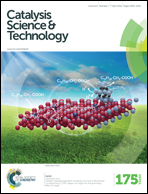Superior performance of mesoporous tin oxide over nano and bulk forms in the activation of a carbonyl group: conversion of bio-renewable feedstock†
Abstract
The efficiency of mesoporous tin oxide as an acid catalyst in the activation of a carbonyl group through selected organic transformations involving the conversion of biomass derived molecules to value-added chemicals is reported. The mesoporous tin oxide was synthesized under ambient temperature using CTAB and was characterized by XRD, FT-IR, SEM, TEM, TGA, N2 sorption, TPD-NH3 and py-FT-IR. It was calcined at different temperatures, showing different physico-chemical properties, and exhibited a wormhole like topology with a large surface area of 160 m2 g−1. The py-FT-IR acidity measurement of the mesoporous tin oxide showed the presence of Brønsted and Lewis acid sites. These acid sites were sufficient to activate the carbonyl group of an aldehyde, a ketone, an acetic anhydride and an amide in selected important organic transformations such as Prins condensation, glycerol carbonylation with urea, ketalization of glycerol with cyclohexanone and acetylation of glycerol with acetic anhydride. In all the above catalytic processes, the mesoporous tin oxide showed superior performance compared to nano and bulk tin oxides. The mesoporous tin oxide catalyst also showed excellent recyclability and remarkable activity compared to the reported catalysts in all the reactions under study.


 Please wait while we load your content...
Please wait while we load your content...